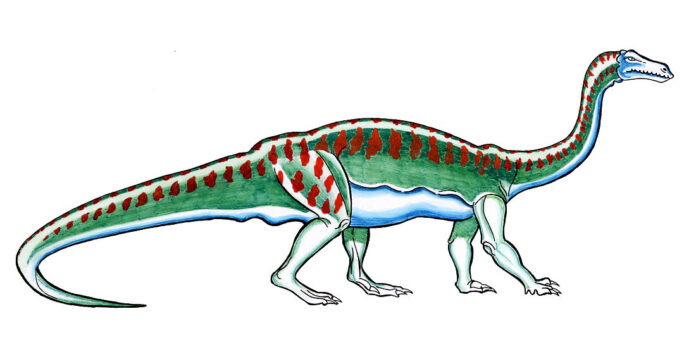Scientists have excavated the largest dinosaur fósil which would have been the largest terrestrial animal on our avión.
Un equipo de científicos de Sudáfrica, Reino Unido y Brasil, liderados por la Universidad de Witwatersrand, han descubierto una fósil de una nueva especie de dinosaurio en Sudáfrica se cree que está relacionado con el brontosaurio. Este dinosaurio jurásico temprano pesaba 26,000 libras, es decir, el doble del tamaño de un elefante africano, y mide cuatro metros de cadera. Se le ha llamado 'Ledumahadi mafube', que significa 'trueno gigante al amanecer' en el idioma indígena Sesotho de la región donde fue descubierto.
Una transición evolutiva
Ledumahadi está estrechamente relacionado con los dinosaurios saurópodos, incluidas las conocidas especies Brontosaurus y Diplodocus. Era un herbívoro herbívoro, tenía extremidades gruesas y era un cuadrúpedo, es decir, caminaba sobre las cuatro patas en una postura similar a los elefantes modernos. En comparación con las largas y delgadas extremidades columnares de los saurópodos, las extremidades anteriores de Ledumahadi estaban más agachadas, es decir, tenían extremidades más flexionadas como los dinosaurios primitivos. Sus antepasados caminaban solo sobre dos piernas y debieron haberse adaptado para caminar sobre las cuatro y es por eso que crecieron para apoyar la digestión ya que eran herbívoros.
Los investigadores compararon fósil data from dinosaurs, reptiles etc who walked on two or four legs and they measured limb size and thickness. This is how they concluded Ledumahadi’s posture and its way of walking on all four limbs. It is understood that many other dinosaurs must have experimented walking on all four limbs which could optimally balance a bigger body. Based upon these collective observations, researchers say that Ledumahadi was definitely a ‘transitional’ dinosaur, as it had ‘crouched’ yet very thick limbs to support its large body. Their limb bones– both arms and legs – are very robust and similar in shape to giant sauropod dinosaurs but obviously thicker while sauropods had more slender limbs. The evolution of four-legged postures came before their giant bodies. Just sheer size and elephant-like limb posture helped them, example sauropods, to become one of the most dominant dinosaur groups during the Jurassic era. Ledumahadi definitely represents a transitional stage between two major groups of dinosaurs. The group of early dinosaurs were experimenting with various ways of becoming bigger in size during the first tens of millions of years of their evolution. What it means for research is that the evolutionary transition from a small, bipedal creature to a large, quadrupled sauropod is a complex path and this evolution certainly led to survival and achieving dominance.
The discovery published tells us that even more than 200 million years ago, these dinosaurs were the largest vertebrates to be present on the avión, and this time period was almost 40-50 million years earlier than giant sauropods were first seen. The new dinosaur is closely related to giant dinosaurs who lived in Argentina around that time supporting the idea that all continents that we see today were assembled as Pangea – a supercontinent comprised of world’s land mass during Early Jurassic. And at that time this region of South Africa was not mountainous as we see it today but was flat and semi-arid with shallow streams. Certainly, it was a thriving ecosystem. Like Ledumahadi, many other dinosaurs – both giant and tiny – roamed the place at the time. It is fascinating that South Africa has helped to understand the rise of giant dinosaurs during Jurassic era.
***
{Puede leer el trabajo de investigación original haciendo clic en el enlace DOI que figura a continuación en la lista de fuentes citadas}
Fuentes)
McPhee BW et al 2018. Dinosaurio gigante del Jurásico más temprano de Sudáfrica y la transición a la cuadrúpedalidad en los primeros sauropodomorfos. Ciencia:. 28 (19). https://doi.org/10.1016/j.cub.2018.07.063
***






































